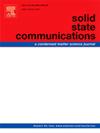Highly conductive metallophthalocyanine assemblies. Structure, charge transport, and anisotropy in the metal-free molecular metal H2(Pc)I
IF 2.1
4区 物理与天体物理
Q3 PHYSICS, CONDENSED MATTER
引用次数: 0
Abstract
That a metal ion is not required for high electrical conductivity is unequivocally demonstrated by structural, charge transport, optical, and magnetic characterization of the simplest phthalocyanine “molecular metal” H2(Pc)I. The crystal structure consists of staggered H2(Pc)+0.33 units stacked at 3.251(3) Å intervals and parallel chains of I−3 counterions. At 300 K, and . At 15 K, σ∼ reaches a maximum of ca. 4000 Ω−1 cm−1 and falls only to ca. 3500 Ω−1‖ cm−1 at 1.5 K. Analysis of single crystal polarized specular reflectance data (ir to uv) yields ωp = 6360(30) cm−1 and a tight-binding bandwidth of 1.3(1) eV. The magnetic susceptibility is Pauli-like (XS = 2.21(5) × 10−4 emu mol−1) except for a small, sample dependent Curie component.
高导电性金属酞菁组件。无金属分子金属H2(Pc)I的结构、电荷输运和各向异性
最简单的酞菁“分子金属”H2(Pc)I的结构、电荷输运、光学和磁性特征明确地证明了金属离子不需要具有高导电性。晶体结构由错开的H2(Pc)+0.33单元以3.251(3)Å的间隔堆叠和平行的I - 3反离子链组成。在300 K时,σ‖= 700 Ω−1 cm−1和σ‖σ⊥>;500. 在15k时,σ ~达到最大值约4000 Ω−1 cm−1,在1.5 K时仅降至约3500 Ω−1‖cm−1。分析单晶偏振镜面反射数据(ir到uv),得出ωp = 6360(30) cm−1,紧密结合带宽为1.3(1)eV。磁化率为泡利型(XS = 2.21(5) × 10−4 emu mol−1),除了一个小的样品依赖的居里分量。
本文章由计算机程序翻译,如有差异,请以英文原文为准。
求助全文
约1分钟内获得全文
求助全文
来源期刊

Solid State Communications
物理-物理:凝聚态物理
CiteScore
3.40
自引率
4.80%
发文量
287
审稿时长
51 days
期刊介绍:
Solid State Communications is an international medium for the publication of short communications and original research articles on significant developments in condensed matter science, giving scientists immediate access to important, recently completed work. The journal publishes original experimental and theoretical research on the physical and chemical properties of solids and other condensed systems and also on their preparation. The submission of manuscripts reporting research on the basic physics of materials science and devices, as well as of state-of-the-art microstructures and nanostructures, is encouraged.
A coherent quantitative treatment emphasizing new physics is expected rather than a simple accumulation of experimental data. Consistent with these aims, the short communications should be kept concise and short, usually not longer than six printed pages. The number of figures and tables should also be kept to a minimum. Solid State Communications now also welcomes original research articles without length restrictions.
The Fast-Track section of Solid State Communications is the venue for very rapid publication of short communications on significant developments in condensed matter science. The goal is to offer the broad condensed matter community quick and immediate access to publish recently completed papers in research areas that are rapidly evolving and in which there are developments with great potential impact.
 求助内容:
求助内容: 应助结果提醒方式:
应助结果提醒方式:


